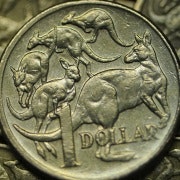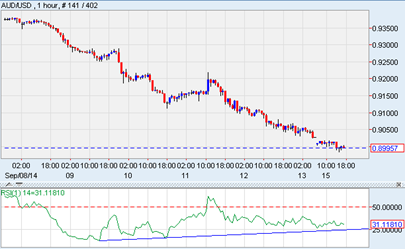A China trap snares the Aussie dollar
The signs have been clear for some time: the Aussie dollar should be lower. Commodity prices and iron ore in particular have been in decline for several months already. The Federal Reserve made it clear early in the year that the quantitative easing program would be coming to an end around October and the European economy never really got moving. China was expected to engineer a soft landing with economic growth to come in at around 7.5 per cent, well below the historical levels, which are closer to double digits.
Despite all these signs, the local unit has been resilient. I expected this phenomenon to continue for a few months yet, so have been surprised by the recent price action. Over the last week the big shift lower intensified once support around the US92c level gave way, pushing it below the psychological US90c level.
With the absence of any new news the question many are asking is -- why now? Why is the Aussie dollar suddenly reacting to information we already knew?
Prolonged China weakness
The market has had some certainty from a US and eurozone perspective since July and this is reflected in the lower euro/US dollar exchange rate. The missing link for the Aussie dollar could have been whether or not commodity price weakness would be temporary. Judging by the last month's round of Chinese economic data it appears that the price reduction, particularly in iron ore, could last for quite a while longer. Hence there appears to be more confidence from institutional investors to start the transition out of what has been a very profitable long-term defacto China play -- being long the Australian dollar.
The weak readings in industrial production and fixed asset investment reported over the weekend are just the latest pieces of information. These have come on the back of a continued slowdown in the property market and slowing retail sales, bringing the government’s 7.5 per cent growth target into question. Some economists have downgraded GDP forecasts to 7 per cent and there is increasing speculation that Chinese officials might do the same.
Will officials respond?
It has been common over the last few years for Chinese officials to respond to weaker economic conditions by providing further stimulus in the form of either loosening the reserve ratio for banks in order to allow them to lend more, or lower lending rates directly loosening monetary policy. The recent rhetoric from Premier Li however may suggest otherwise.
It appears that the Chinese government may be willing to accept lower growth in the short term, with the Premier last week saying that recent data is still "within a reasonable range" and that China will maintain "prudent monetary policy with targeted easing". These comments suggest broad based monetary policy easing is less likely, and that China may prefer to continue to focus on extra support at the grass roots level to help agriculture and technology industries.
Is the selloff overdone?
If we don’t get a response from Chinese policy makers, Janet Yellen's press conference is still on the dovish side and the iron ore price can recover from $80 area then we could see the Aussie back in the next few weeks.
The negativity surrounding the Aussie dollar at the moment has seen December futures pricing the Australian dollar/US dollar exchange at around US89.5c by year’s end, which is not that far away from current the current market rate.
Jim Vrondas is chief currency strategist, Asia-Pacific at OzForex, a global supplier of online international payment services and a key provider of Forex news. OzForex Group Limited is a publicly listed entity with shares traded on the Australian Securities Exchange under the code "OFX".

















